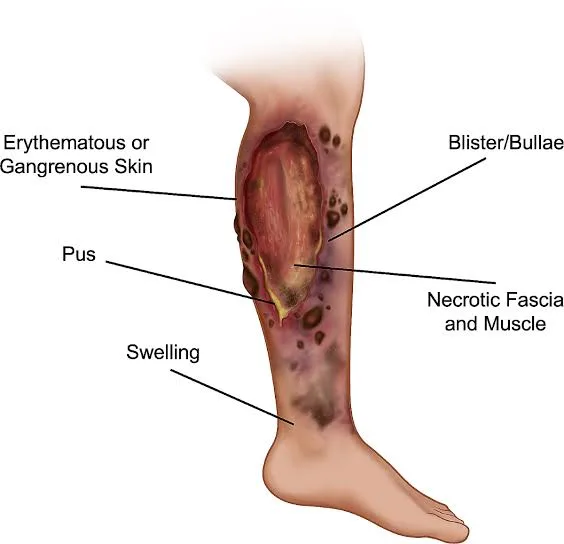Today marks Necrotizing Fasciitis Awareness Day, a crucial observance dedicated to educating the public about necrotizing fasciitis, commonly known as “flesh-eating bacteria.” This rare but severe bacterial infection can progress rapidly, leading to devastating consequences if not promptly treated.
*Understanding Necrotizing Fasciitis*
Necrotizing fasciitis is caused by various bacteria, including Group A Streptococcus, Klebsiella, Clostridium, Escherichia coli, Staphylococcus aureus, and Bacteroides. These bacteria can enter the body through cuts, burns, or other wounds, and in rare cases, through surgical sites. The infection destroys the soft tissue and fascia beneath the skin, often leading to severe pain, swelling, and potentially life-threatening complications.

*Symptoms and Diagnosis*
Early symptoms of necrotizing fasciitis can be similar to those of other less severe infections, making it challenging to diagnose. Key signs include:
– Severe pain that worsens over time
– Swelling, redness, and warmth around the affected area
– Fever and chills
– Blisters or black spots on the skin
– A general feeling of illness or malaise
Prompt medical attention is critical. Diagnosis typically involves a combination of physical examination, imaging tests, and laboratory analysis of tissue samples.
*Treatment and Recovery*
Treatment for necrotizing fasciitis usually involves:
– *Antibiotics*: High doses of intravenous antibiotics are administered to combat the bacterial infection.
– *Surgery*: Surgical debridement, or the removal of infected tissue, is often necessary to control the spread of the infection.
– *Supportive Care*: Patients may require intensive care, including fluid replacement, oxygen therapy, and management of any underlying health conditions.
Recovery can be lengthy and may involve multiple surgeries, physical therapy, and psychological support. In severe cases, necrotizing fasciitis can result in significant morbidity and mortality.
*Raising Awareness and Promoting Prevention*
Necrotizing Fasciitis Awareness Day aims to educate the public about the importance of prompt medical attention for signs of infection and proper wound care. Preventive measures include:
– Keeping wounds clean and covered
– Monitoring for signs of infection
– Seeking immediate medical care if symptoms worsen or do not improve with treatment
– Practicing good hygiene, particularly in healthcare settings

*Community Support and Research*
Awareness campaigns also highlight the need for continued research into necrotizing fasciitis. Advances in diagnosis, treatment, and prevention strategies are crucial for improving outcomes for those affected by this disease.
Support groups and online communities provide valuable resources for patients and families dealing with the aftermath of necrotizing fasciitis. These networks offer emotional support, share experiences, and raise funds for research and awareness efforts.
*A Call to Action*
As we observe Necrotizing Fasciitis Awareness Day, it’s essential to spread knowledge about this serious condition. By understanding the risks, recognizing the symptoms, and advocating for prompt medical care, we can work together to reduce the impact of necrotizing fasciitis.
If you or someone you know is experiencing symptoms of necrotizing fasciitis, do not hesitate to seek medical help. Early intervention is key to preventing severe complications and improving outcomes.
Let’s use this day to raise awareness, support those affected, and push for continued research into this devastating disease. Together, we can make a difference.
